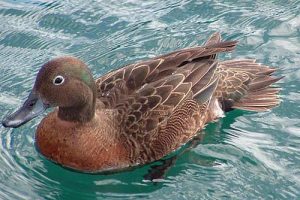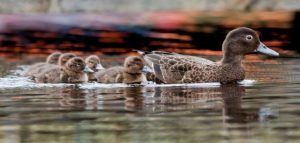Brown Teal / Pateke
Brown teal are endemic to New Zealand and, in pre-human times, may have been the most widespread and numerous of New Zealand’s waterfowl. The brown teal was an abundant and widespread species 200 years ago, but became highly endangered due mainly to the impacts of introduced predators.
IDENTIFICATION
Both sexes of brown teal are darkish brown, but they are sexually dimorphic in plumage and size. Both sexes have a conspicuous white eye ring, dark-grey bill, legs and feet, and dark brown eye. Their wings appear short, their upper and lower surfaces brown and the speculum on the secondary feathers is green.

Length: 48 cm
Weight: 650 – 900 grams
Males in breeding plumage have an indistinct green iridescence on the head, occasionally a narrow white neck ring, dark chestnut breast, and conspicuously barred light and dark brown flank feathers with a whitish patch at the tail base.
Voice: male calls are soft, usually described as trills or piping, given in alarm and in territorial defense.

Length: 45 cm
Weight: 550 – 800 grams
Females and juveniles are a uniformly dull but dark mottled brown.
Voice: The female has a rasping growl and a high-pitched and rapid quack.
Distribution
Wild Brown teal populations reduced down to just two restricted populations in the North Island (Northland, Great Barrier Island) but have been have been expanding due to extensive predator control and new populations being formed via the National Captive Re-introductions program.
[mapsmarker layer=”4″]
The brown teal population got down to as low as just 700 birds estimated in the wild in the year 2000. Since then an intensive conservation program by the Department of Conservation – Pateke Recovery Group have increased the population back up around 2500 birds in the wild.
Reintroductions
With successfull releases of captive birds back into the wild from the Brown Teal captive breeding program, we now have sustainable populations established in Corromandel, Tawharnui, Cape Kidnappers, Tutukaka, Purerua (Kerikeri) and Arthur Valley (Milford Sound) still in progress.
Even with all this great work which has changed the population trend from a decline towards extinction to now steadily increasing and in the recovery phase, numbers are still fewer than 2000 – 2500 Brown Teal in the wild, making the species the rarest waterfowl on the New Zealand mainland. The Department of Conservation, the volunteer captive breeding facilities (20), community groups and sponsorship partners have all helped make this program the success it is today.
Threats and conservation
The brown teal are making a conservation comeback as a species, but is still very reliant on effective predator control to maintain and grow their numbers. Their vulnerability to and exposure to mammalian predators is the main reason for their decline, the main introduced predators are stoats, cats, ferrets, dogs etc.
Loss of wetlands and habitat has also played its part, but even the best pateke habitat without predator control will not sustain them. Whereas even marginal habitat with effective predator control has proven successful.
Recovery of teal populations on mainland sites requires permanent and assiduous predator control or predator exclusion.
Behaviour and ecology
Brown teal formerly exploited a wide range of habitats including wet forests, extensive and occluded swamps, slow-flowing streams, lakes and estuaries. Their present day habitat lies mostly in agricultural environments wherein the birds use stock ponds as breeding and feeding sites, and also margins of small streams/drains that retain overhanging marginal vegetation.
Brown teal populations generally comprise a single aggregated flock and numerous widely dispersed pairs. Some pairs may occupy exclusive territories year-round in water-rich locations whereas others vacate their territories seasonally and return to them when autumn rains replenish water levels. These territories contain abundant food and escape cover and suitable nesting and brood-rearing habitat. Pairs using streams as territorial sites will forage and nest well beyond the stream margins.
Flocks arise from mid-summer aggregations of recent fledglings and of early moulted adults whose winter ranges have dried out. Other seasonally displaced adults also join but will leave the flock following autumn rains. Non-breeding birds may remain as a flock through winter and spring.
Brown teal are generally crepuscular to nocturnal in habit in agricultural and forested environments but at coastal sites feeding and loafing activity may also be influenced by tides, the birds being more active at low tides.
Food
Brown teal diet is diverse. A study from Great Barrier Island recorded 78 taxa including terrestrial, freshwater and marine invertebrates, fungi, and terrestrial and freshwater vegetation. Terrestrial foods included seeds of sedges, clover leaves, cased caddisfly larvae, beetles, caterpillars, moths and earthworms. In inter-tidal areas teal dabbled in soft sediments to extract gastropods and bivalves, crustacean and polychaete worms. They also extract flesh from cockles and small mussels. On freshwater ponds, teal have been observed eating leaves of various wetland plants.

